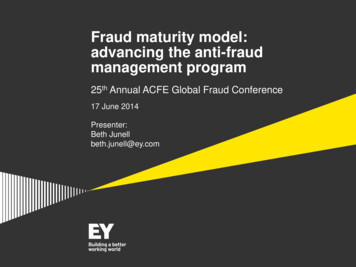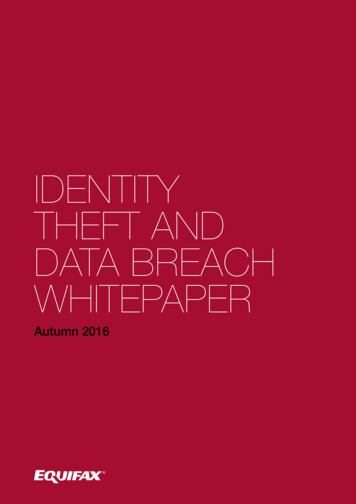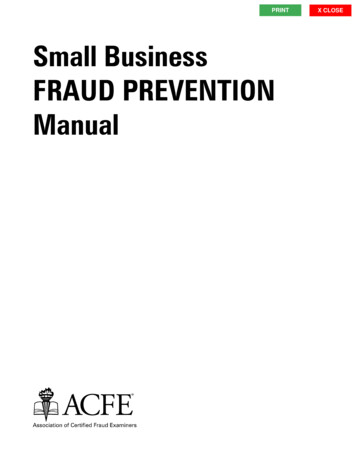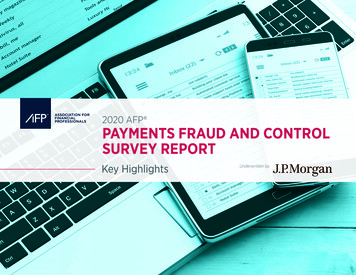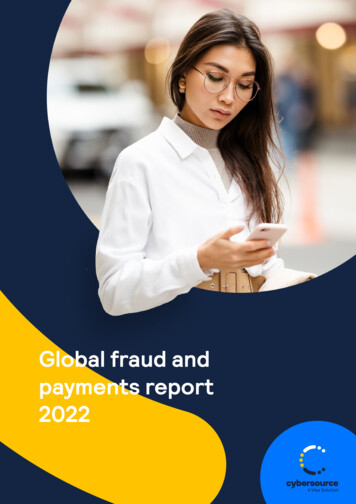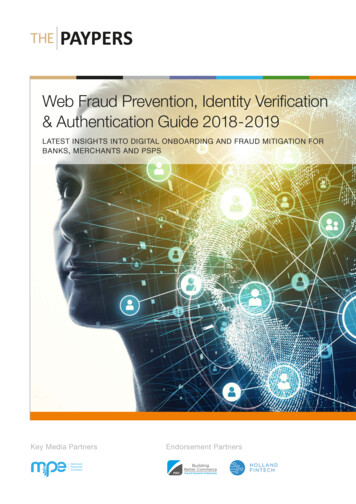
Transcription
Web Fraud Prevention, Identity Verification& Authentication Guide 2018-2019LATEST INSIGHTS INTO DIGITAL ONBOARDING AND FRAUD MITIGATION FORBANKS, MERCHANTS AND PSPSKey Media PartnersEndorsement Partners
Web Fraud Prevention, Identity Verification& Authentication Guide 2018-2019LATEST INSIGHTS INTO DIGITAL ONBOARDING AND FRAUD MITIGATIONFOR BANKS, MERCHANTS AND PSPSContact usFor inquiries on editorial opportunities please contact:Email: editor@thepaypers.comTo subscribe to our newsletters, click hereFor general advertising information, contact:Mihaela MihailaEmail: mihaela@thepaypers.comRELEASE VERSION 1.0DECEMBER 2018COPYRIGHT THE PAYPERS BVALL RIGHTS RESERVEDTEL: 31 20 893 4315FAX: 31 20 658 0671MAIL: EDITOR@THEPAYPERS.COM
Editor’s letterCustomer experience and the conflict between offering a fric However, fraud attacks are becoming more sophisticated, withtionless customer service to good clients while managing riskfraudsters having access to the latest technology and sophisticatedand blocking the bad guys are some themes that are emergingtools. Therefore, what is really needed? A fraud managementfrom acquirers, card schemes, regulators, service providers,solution can track the customer’s behavioural patterns (beha-merchants, as well as auditors and journalists alike.vioural profiling) and instantly detect and report any signsof fraud, triggering a step up authentication to mitigate theIdentifying fraudulent behaviour without rejecting or offendingpotential risk (risk-based authentication).good customers is key because a blocked good customer willnot return, and as the market is so competitive, they can go every-Similarly, when it comes to financial institutions (FIs), FIswhere. Moreover, automation technologies based on machineare under intense competitive pressure to make the bankinglearning and artificial intelligence are gaining prominence in thisexperience easier and frictionless (while regulators in Europeconversation. But, as always, some challenges in addressing theseappear to be taking the industry in a different direction, thanks tothemes, security-wise, still remain.the second Payment Services Directive’s requirement for StrongCustomer Authentication).The Web Fraud Prevention, Identity Verification &Authentication Guide 2018-2019The faceless nature of the online and mobile channels makesTo respond to some of these challenges, we have released ourauthentication hard, however the large amounts of data that have7th edition of the Web Fraud Prevention, Identity Verificationbeen breached in recent years combined with fraudsters’ use of& Authentication Guide to provide payment and fraud and riskphishing, social engineering, and malware make authenticationmanagement professionals with a series of insightful perspectivesmuch more difficult. As a result, some of the top threats for 2018from industry associations and leading market players on keyin ecommerce and banking are account takeover and newaspects of the global digital identity, transactional and web fraudaccount applications, according to Aite.detection space.For Europe especially, but also for the US, Canada and Australia,The guide is structured in three parts; the first part focusesin 2018, financial discussions revolved around Open Bankingon presenting the industry, with its most acute problems, butinitiatives. The concept of open banking promises users greateralso shares some best practices from industry leading players oncontrol over their financial data; however, it is not without risks,how to tackle them. With the advent of digitalisation and the useand its success is tied to consumer confidence when it comesof smartphones, business and fraud coexist globally, both seento the security and privacy of their information.as profitable activities, involving large masses of customers.The surge in demand for many goods and services has enabledAt the moment, businesses have become incredibly dependentnot only businesses’ profits to soar but also fraudsters toon a network of systems to manage, store, and transmit infor capitalize on this growth. Bad actors are tricking retailers/mation such as financial accounts, personally identifiable informa merchants/banks by hiding beneath large transaction volumestion, intellectual property, transaction records etc. Within this web,and exploiting the fact that many products and services providersauthentication, validation and verification have turned out to beare willing to accept a greater degree of risk in order to approvecentral to the ability of these businesses to effectively securemore orders.access to consumer-facing digital channels and the systems thatunderpin their operations. Key challenges for businessesOne of the biggest challenges in the fraud detection space forretailers/merchants is that for consumers, a transaction needsto happen in the blink of an eye, and therefore fraud controlsshould be invisible for them.3WEB FRAUD PREVENTION, IDENTITY VERIFICATION & AUTHENTICATION GUIDE 2018-2019
The right tools for fighting fraudConclusionThe second part of our Web Fraud Prevention, Identity Verifi Businesses may think they understand fraud, but the realitycation & Authentication Guide 2018 2019 focuses on mappingis far more complex, and this lack of insight could lead tothe key players in the fraud detection, identity verificationguessing, incorrect conclusions, and bad decisions. Premisesand online authentication space. The chapter aims to createsuch as the fraudsters as geeky guys, conducting their activi an accurate picture of what the fraud detection, identityties at night in their basements, and living somewhere inverification and online authentication offerings looks like, andEastern Europe, or that ATOs are relatively low profile eventsit displays the key players of the industry together with theircould shape businesses’ fraud-fighting operations from top tomain capabilities. Depicting the most important features of eachbottom. Moreover, these assumptions help determine how ana-company is part of our goal of helping merchants, banks, fintechslysts set up rules, how many people the fraud team hires andand payment service providers to grasp the current marketstaffs on a given day, and so on.opportunities and to use them according to their own needs.Therefore, security and risk management leaders responsible forThe whole range of capabilities is designed to address the painfraud prevention and payment security should align with cross points that organizations in the payments space are strugglingorganisational groups (security, identity and access management,to remove. To do so, security and risk management leaderscredit/underwriting) to detect high risk or anomalous activityinvolved in online fraud detection have started using machine and identity, and tap into technologies that enable fightinglearning analytics, cloud based deployment options, artificialagainst these threats. And if we consider the large amounts ofintelligence, behavioural analytics, and massive global dataharvested data, the capability of analysing and connectingnetworks.data across channels is vital for strong defence.Such technologies generate real-time insights into the nuancedEnjoy your reading!patterns of fraud to enable businesses to spot and fight fraud.These patterns are based on geography, industry, time of day,Mirela Ciobanutime of year, and over 15,000 other signals. Fraud managementSenior Editor, The Paypersspecialists/vendors have developed networks that analysemillions of transactions in real time across billions of devices.Finally, the third part of our Web Fraud Prevention guide, theCompany Profiles section, offers insights into the capabilitiesfraud prevention companies offer businesses in order to spotfraudulent attacks, stop them and prevent them from happening.Obviously, we would like to express our appreciation to theMerchant Risk Council and Holland FinTech – our endorsementpartners who have constantly supported us – and also to ourthought leaders, participating organisations and top industryplayers that contributed to this edition, enriching it with valuableinsights and, thus, joining us in our constant endeavour to depictan insightful picture of the industry.To view the report in its entirety, please click here.4WEB FRAUD PREVENTION, IDENTITY VERIFICATION & AUTHENTICATION GUIDE 2018-2019
Customer Onboarding and IdentityVerification
An Introduction to Customer Onboardingand Digital Identity VerificationMirela Ciobanu Senior Editor The PaypersDid you know that 59% of customers looking to open a bank account have walked away from online applicationsin the last 12 months? The reason behind this: many application processes aren’t really designed for the digital age.However, the good news is that smart fintech businesses and challenger banks are getting under the skin of digital identity and using our uniqueness to unlock a frictionless future. They do so by tapping into technology such as behaviouralbiometrics, machine learning and artificial intelligence, and lately also blockchain to support secure, intuitive and personalised digital experiences that are beneficial for both companies and consumers alike.In this chapter, we will see how the onboarding process looks like, not only from a customer’s perspective working witha financial services institution (FI) or other regulated entities, but also from a FI’s perspective onboarding new clients.Banks are looking for ways to increase conversion of new customers applying for their product/service, be relevant for them,while also managing risks associated with KYC/onboarding processes. But customers are demanding a flexible (mobilefirst) and modular onboarding process, and regulators are constantly watching the market and updated/adopt newregulations (e.g. AMLD5).Will banks be able to get this puzzle right, in time? After all, improving the customer onboarding experience should be apriority for financial institutions, especially since regulations such as PSD2 will enable customers to change their financialservice provider more easily.Onboarding new customers in a digital world: a bank’s perspectiveAfter a few years of battles between incumbent banks and smart fintechs/challengers, everyone has agreed that digitalcustomers need digital processes. Nowadays, for many financial services organisations, the onboarding process isconsidered costly, prone to fraud and creates unnecessary friction in the customer’s experience. This old approach is simplynot sustainable as it gives rise to high abandon rates and does not meet the expectations of a younger digitally ‘native’customer.How is my current onboarding process performing? The incumbentsBecause many application processes aren’t really designed for the digital age, incumbent banks just replicate traditionalonboarding processes, pushing only some parts of it online. As a result, up to half of digital applicants can’t actuallycomplete an application online; instead, they have to go into a branch to verify their identities, or submit additionaldocumentation. 90WEB FRAUD PREVENTION, IDENTITY VERIFICATION & AUTHENTICATION GUIDE 2018-2019
An Introduction to Customer Onboardingand Digital Identity VerificationIn 2016, Signicat conducted a research called the Battle to On-board that aimed to portray the onboarding processes forthe UK financial services consumers. The research found that 40% of consumers had abandoned bank applications;more than 1 in 3 (39%) abandonments were due to the length of time taken and a third (34%) were due to demanding toomuch personal information. Interestingly, the company performed the same research two years later and the resultswere similarly devastating for banks. In fact, it was worse than ever in the UK, with 56% of respondents havingabandoned an application. Among other impediments for applying cited by consumers were the fact that they had toprovide personal information by post or take it into the branch, and sometimes the language used by the bank wasconfusing.Nevertheless, some progress has been made with banks such as China Merchant Bank, one of the largest credit cardcompanies in China, Wells Fargo and the Bank of America that have reached out to AI assistants to improve customerexperience. For instance, Bank of America’s ‘Erica’ chatbot was designed to maximise the opportunities of thegrowing demand for mobile banking and is capable of anticipating the financial needs of each individual customer andsending them personal smart recommendations to help them achieve their financial goals.In Europe, most innovative banks such as ABN AMRO, CaixaBank and BBVA have developed their own hassle-freebanking brands to cater for millennials and digital savvy users. For instance, in Spain, CaixaBank launched in 2016imaginBank, a mobile banking service that enables users to control their finances, view their account securely withinFacebook, or draw money from an ATM without a card and send money to friends using only a mobile number. Similarly,present in the Netherlands, Germany, Belgium and Austria, Moneyou, a brand of ABN AMRO, is a mobile banking serviceconnected to a mobile app called Tikkie. The app can be used by anyone, regardless of who they bank with; it is onlynecessary that the person receiving the money to have the app. Once the users enter their name, mobile phone numberand the IBAN number, they can start sending payment requests via WhatsApp, Facebook Messenger, Telegram, QR-codeor text (SMS).How is my current onboarding process performing – the challengersEven from the first encounter with the clients, challengers have been praised for providing great user experience. Andwhy is that? They are digital, they can develop from scratch, have smaller product offering, they do not depend onlegacy systems, and are adopting new technologies to automate identity verification processes.For example, Fidor Bank, a German online bank, founded in 2009, has a simplified, three stage process of onboardingdepending on two essential variables: customer behaviour and product complexity. For the Fidor’s Smart Cash Accountproduct, the entry point for a new customer is to join the Fidor community, by supplying one’s credentials from Facebook,with no obligation to buy anything. Step two is obtaining a pre-funded online ‘wallet’ that can be used to move moneywithin a closed loop as the user graduates to being a ‘customer’ after passing reduced KYC. This allows him or herto test out Fidor, again without any further commitment, while still being part of the community. The third and laststep is to open a more traditional account after passing full KYC. Now the customer can also trade commodities, FX, anddigital currencies. 91WEB FRAUD PREVENTION, IDENTITY VERIFICATION & AUTHENTICATION GUIDE 2018-2019
An Introduction to Customer Onboardingand Digital Identity VerificationSo, the Fidor Smart Cash Account behaves according to the way the customer registers, not according to a bankimposed process.In general, banks must check the identity of everyone opening an account to prevent money laundering or other criminalfinancing activities. While these ID checks used to take place exclusively at bank counters, nowadays many services usevideo identification customers rotate their ID card in front of a camera allowing staff to check for security features, likeholograms or just selfies.However, this simplicity might come at a cost. Germany’s N26 could be potentially vulnerable to money launderingand terrorism financing, according to a German publication WirtschaftsWoche, which exposed a security gap at the onlinebanking startup. As the fintech rolled out a selfie validation procedure for account opening, it is easier for criminals to openaccounts with fake IDs. A WirtschaftsWoche correspondent saw how a man scanned a friend’s ID, added his own passportphoto to the ID, printed it out and stuck it atop of a white plastic card that was the same size as the office ID card in hiscountry. He cut the edges to make them round and the result was a new identification card that could be used to open anew bank account.“Go online or go home” – ways to improve itINNOPAY developed a Benchmark that provides banks with essential insights into how to make a good firstimpression on customers. INNOPAY consultants have identified six key actions that banks should execute in order toprovide the prospective customers the best-possible onboarding experience and increase conversion rates.1. Eliminate all channel breaks to support an end-to-end fully digital onboarding experience. For example, banks shouldadopt paperless onboarding processes as well as processes for which no physical signature is required.2. Make required onboarding information and prerequisites transparent and understandable for the user. For instance,clear information and communication are key, so that the potential customer has all relevant details at hand and canrun through the process in a smooth way.3. Guide the customer through the onboarding flow and empower customer support to help prospects during onboardingin a quick and high-quality manner. The end result is that the prospects always know where they are currently positionedwithin the process and find information quickly. If they do not understand why the bank is asking for certain information orwhy the bank requires the prospect to use a certain identification method, they can rely on professional support providedby the bank.4. Make use of tools that ease the process of data entry and eliminate errors. Thus, errors can be prevented by variousin process validation tools to increase conversion and also to reduce manual efforts by the bank, leading to costreduction.5. Enable customers to instantly login and start using the payment account after a successful onboarding.6. Deliver a consistent look and feel throughout the whole onboarding experience. 92WEB FRAUD PREVENTION, IDENTITY VERIFICATION & AUTHENTICATION GUIDE 2018-2019
An Introduction to Customer Onboardingand Digital Identity VerificationOverall, we can conclude that banks can stay relevant for their customers if they transform the entire on-boarding processonline. So far, we have seen that consumers are more likely to apply for a product if the process is 100% online and ifpaper-based identity checks are eliminated.Moreover, the onboarding process could be accelerated if they could use their verified physical ID, such as a passportor driving license, and here, in the 100% online application process, an important role is played by identity verification.Identity verification: some last thoughtsIdentity verification is proving that specific identity attributes are actually connected to the person, entity, or thing thatthey are intended to represent. According to Josje Fiolet, Digital Onboarding lead at INNOPAY, video identification,reading the chip of the document via NFC (Near-Field Communication), using eID solutions, or taking a picture of theID document can enable businesses to answer questions such as ‘Is the customer’s document valid?’, or ‘Is the personreally who he/she claims to be?’.To build a reliable profile of the customer, other techniques can also be considered. The trail of data that we leave behindmay not be an identification method in itself, but it can serve as an additional step when building a trustworthy profile. Forexample, our activity on social networks can be used to provide a certain level of assurance of someone’s identity, andthe account’s profile picture can be matched with the picture in the identification document.For effective client identification, a business must have access to a range of technology solutions that can indicatethe veracity of an individual along with providing access to worldwide trusted datasets that contain billions of dataelements of information from governments/public bodies, including global postal, telecoms and other public data, tovalidate the underlying data associated with financial services provision. Not only does this deliver a 360 degree view ofthe individual, but it also authenticates who they are.The key to all these lies in balancing these elements in order to create perfectly tailored products. By understandingthe unique needs of customers, financial businesses can help governments and major institutions fight fraud and grantaccess to underserved and legitimate customers. We can conclude by underlying one of Money 2020’s ideas from the2018 edition: once we solve this puzzle of identity custodianship, we can craft a masterpiece in which uniqueness iscelebrated, protected and used responsibly.93WEB FRAUD PREVENTION, IDENTITY VERIFICATION & AUTHENTICATION GUIDE 2018-2019
TruliooHard Problems: Identity Verification, Fraud Prevention and the Giant Leap TowardsFinancial InclusionAbout Zac Cohen: Zac Cohen is a versatile leader experienced in managing and scaling high-growthcompanies. Zac is currently the General Manager at Trulioo – a hyper-growth Vancouver startup solvingglobal identity challenges associated with international regulatory compliance, fraud prevention, andtrust and safety online. He is passionate about fostering change-makers who want to make an impactand are engaged in building groundbreaking solutions to solve our world’s most pressing problems.Zac Cohen General Manager TruliooAt the turn of this decade, the “GDP of the internet” began risingThe challengeprecipitously; online merchants, particularly micro-merchants,As it happens, the success of both CDD and fraud preventionbegan opening online storefronts in increasing numbers. Yet thehinge on a critical process: Identity verification. When it comestechnology powering the flow of money online was simply notto highly competitive and fast-growing companies, it becomeskeeping pace. It was this set of unique circumstances that necessi-imperative to move quickly and capture as much market sharetated the creation of a new generation of payment solutions. Withas possible. For these companies, it becomes essential to havetheir elegantly simple code and their vast network of relationshipsan identity verification process that can scale quickly, efficiently,with credit card issuers, banks and financial services, theseand cost effectively. In order to do that, these companies needpayment solutions open the doors to a truly borderless market-access to a variety of trusted and reliable data sources; but, asplace where online merchants and buyers could transact freely.it happens, the data that is being sought to verify the identity ofmerchants in these markets is often available exclusively withA layer of trustlocal data vendors.There was, however, another problem that stood in the way: If thesepayment solutions wanted to enter new markets, particularlyConsider a growing payments company; let’s say it is foraying intounchartered and unfamiliar ones, they needed to first build a layerthe Peruvian market. It will likely struggle to forge relationshipsof trust between themselves and their new customers – the onlinewith local data partners there; it would have to sign multiplemerchants.contracts with multiple data partners in order to gain access toa sufficiently large swathe of identity data. This process requiresThis layer of trust needs to be built on:a great deal of time, resources and familiarity with the local eco- Customer due diligence (CDD): Ensuring a level of CDD that issystem; identifying, procuring, and vetting data sources, and thencommensurate with the risks involved in transacting with newmanually undertaking security and compliance checks. Even fromcustomers in these regions. For payment companies, banks,a technology standpoint, the time and investment required to buildand financial services providers, this includes meeting regulatoryan API for every data source that the company intends to tap into,requirements such as Know Your Customer (KYC), Anti become critical roadblocks to their expansion plans. Given theseMoney Laundering (AML).constraints, it would take anywhere between six months to a year Fraud prevention: While the digital economy has created unpre for these companies to integrate each data source onto theircedented opportunities for both established and upstart mer-systems. Now, consider the total time it would take to integratechants around the world, it is also prone to fraud. Indeed, preven-with multiple data sources across multiple countries; that’s whention is the operative word here, because very often fraud is onlythe project begins to look unfeasible. detected after the fact.96WEB FRAUD PREVENTION, IDENTITY VERIFICATION & AUTHENTICATION GUIDE 2018-2019
The solution: a single API to access identity dataacross the worldTrulioo has, to a large extent, mitigated this problem; as one of theworld’s preeminent identity verification solutions, we have accessto hundreds of data sources. Through a single API, GlobalGateway Trulioo’s flagship solution provides secure access to over 400data sources across the world. With GlobalGateway, our clientsAbout Trulioo: Trulioo is a global identity verificationno longer need to sign multiple contracts with multiple parties;company providing advanced analytics from traditionalinstead, a single contract with Trulioo provisions it with access toand alternative data sources to verify identities in real-data from multiple data partners. In fact, one of the world’s leadingtime. Through GlobalGateway, Trulioo’s electroniccross-border payroll solutions uses GlobalGateway to verify theverification platform, clients are able to streamline theiridentity of payees in 52 countries across different continents,cross-border compliance needs, helping them meetincluding Chile, Jordan and Egypt.Anti-Money Laundering and Know Your Customerrequirements, while simultaneously mitigating fraud andInstant access to a plethora of data sources also goes a long wayreducing risk.in mitigating risk; for instance, companies tend to put off their CDDprocess till such time as a merchant starts transacting beyond awww.trulioo.comcertain dollar threshold — this is mainly because traditional processes of identity verification were manual, slow and required muchhuman effort. The instantaneity of identity verification, which TruliooClick here for the company profileenables, allows companies to place identity verification at thevery beginning of merchant onboarding; the same instantaneitymakes it easy for many of our clients to verify (rather, reverify) theidentities of their existing merchants. As a result, our clients areTo that end, we began partnering with MNOs around the world.able to understand their entire consumer base quickly and takeCurrently, we have access to identity data provided by dozens oftimely cognizance of any risks that their merchants might pose.MNOs, which cover 1.8 billion mobile users. When the traditionalKYC-compliant sources of data are combined with MNO data,Mobile ID verification: a boost for financial inclusionone is able to obtain more insight into the identity that one is tryingand an antidote to fraud preventionto verify. No less important is the added value that MNOs bring toFrom very early on, we, at Trulioo, saw identity verification as afraud prevention; for example, when verifying a merchant’s mobilecatalyst for financial inclusion; to that end, we realised that wenumber against MNO data, GlobalGateway can flag numbers thatneeded to cover hard-to-reach areas, which lacked traditionalare VoIP numbers, which are often prone to misuse by fraudsters.sources of identity data. As of October, Trulioo can verify theidentity of up to five billion people, or two-thirds of the world’sWe are one breakthrough away from financial inclusionpopulation, along with 250 million businesses, including micro-If we look back at the evolution of online commerce, we realisemerchants. In developing areas of the world, where a large part ofthat at different points, there have been different technologicalthe population is “unbanked”, and traditional sources of identitybreakthroughs that have catalysed the sector in different ways.data have limited coverage, mobile network operators (MNOs)The revolution in online payments was one such breakthrough;can play a game-changing role. In developing markets, the mobileidentity verification is on the cusp of being the next breakthrough.user base outstrips that of financial services: for instance, over theToday, merchants from around the world can transact online aslast four years, over a billion mobile accounts were opened aroundfree agents of the online economy; our dream is to see a worldthe world, compared to 500 million bank accounts. Indeed, thewhere they are able to transact not just as free agents but equalsdata in possession of MNOs can go a long way in verifying theof a financially inclusive ecosystem.identity of otherwise “thin file” merchants.97WEB FRAUD PREVENTION, IDENTITY VERIFICATION & AUTHENTICATION GUIDE 2018-2019
3 WEB FRAUD PREVENTION, IDENTITY VERIFICATION & AUTHENTICATION GUIDE 2018-2019 . Merchant Risk Council and Holland FinTech - our endorsement . Wells Fargo and the Bank of America that have reached out to AI assistants to improve customer experience. For instance, Bank of America's 'Erica' chatbot was designed to maximise the .
